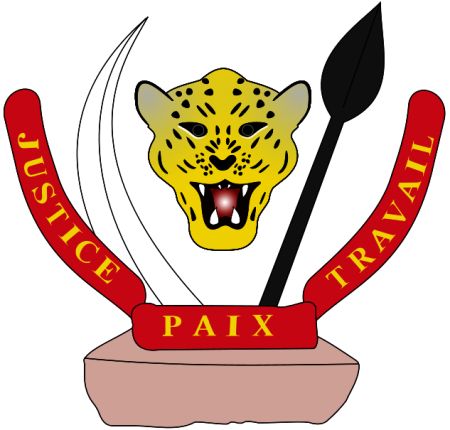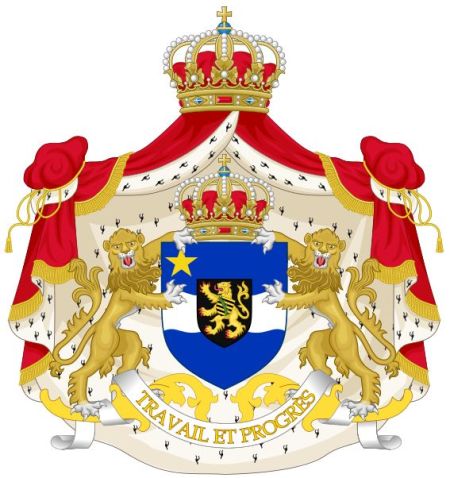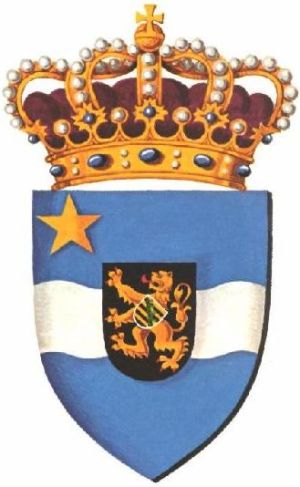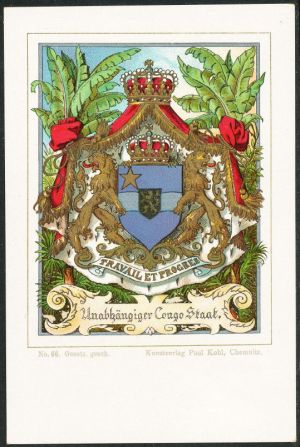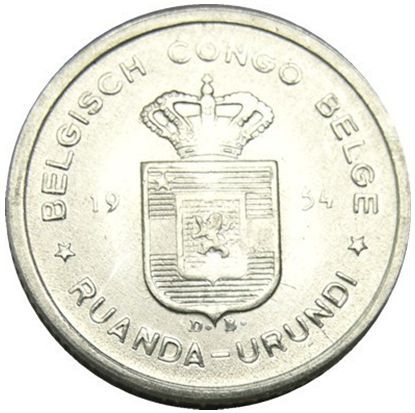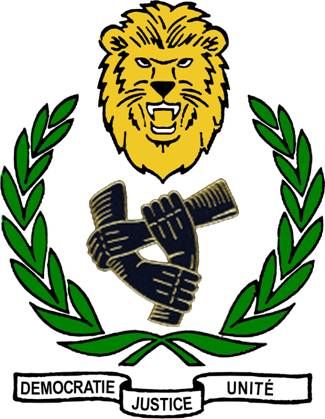National arms of Congo
| Heraldry of the World Civic heraldry of Congo |
NATIONAL ARMS OF CONGO
Official blason
Origin/meaning
The current emblem has been adopted on February 18, 2006.
The emblem shows a leopard's head, a spear and a elephant's tusk. These are the traditional symbols of power of the local rulers in the 19th century and appear first in the arms of Congo in 1963.
The Independent State of Congo (1884-1908)
The heraldic history of Congo begins on June 21, 1877, when the African International Association (AIA), created in September 1876 on the initiative of the King of Belgium Leopold II "to open Africa to the civilisation and to abolish the draft of the slaves", chooses as emblem a blue flag with a golden star in the centre. The star symbolised the hope enlightening the African darkness. This flag supposedly was designed by the king himself.
Used by several explorers engaged in the service of Leopold II, who hoisted it on the stations which they install on the Congolese territory, this flag quickly becomes the mark of King Leopold II in central Africa.
The symbolism was adopted again in 1882 by the International Association of Congo (IAC) which had been created in the meantime by the King. At the Congress of Berlin, in February 1885, the IAC becomes the Independent State of Congo (ISC) and Leopold II becomes the sovereign.
On May 29, 1885 the Independent State of Congo was granted its arms, based on the design of the flag.
| The large arms |
The small arms |
| The arms of a postcard +/- 1905 |
The arms shows the star from the flag of the AIA, the river Congo and as an inescutcheon the arms of the King himself. These were granted to him in 1880 and showed the lion of Belgium, with a small shield of Saxony, for the Sachse-Coburg und Gotha dynasty. The arms also show the supporters and mantling of the Belgian kingdom, and the motto Travail et Progress (Labour and progress).
After the death of King Leopold, his 'private colony' was transformed into the Belgian Congo.
Belgian Congo (1908-1960)
The Belgian Congo still used the old arms, with or without the small shield of Saxony.
| The arms on a coin |
The small arms |
| The arms of a postcard +/- 1905 |
The emblem replaced the previous emblem, which was adopted in 2003.
This emblem showed a lion's head above three human arms.
Congo-Kinshasa (1960-1966)
Democratic Republic of Congo (1966-1971)
Zaire (1971-1997)
congok.jpg
In a general way, the armorial of Congo - civic or private - will remain hardly influenced by this first flag. In particular, the successive national coats of arms will be rather directly inspired by the national flags chosen in the various times of its animated history.
After the transfer of the Independent State of Congo to Belgium, the Belgian law of 18/10/1908 clarified that Belgian Congo could continue to make use of the seal and the flag which had used the Independent State of Congo. The arms thus officially were never modified until the independence of Congo in 1960.
They nevertheless were simplified. The small shield of Saxony officially remained part of the arms, although it was often removed, in spite of the fact that the royal house stopped using it and officially disappeared from the royal coat of arms after the 2nd world war. The reason is there that this small shield on the lion is the personal mark of Leopold II, of whom it calls back the colonising initiative, and not of Belgium, nor even the dynasty.
Similarly the wavy bar was often transformed into a regular bar, and thus the arms below, although unofficial, were widely used.
congo2.jpg
On the other hand, the official Belgian administrators still used the official arms, combined with the Belgian National arms. Under the two shields the two mottos were shown : 'Travail et progrès' (work and progress) for Congo and 'L'Union fait la force' (the union provides strength) for Belgium (see below).
congo3.jpg
In 1960 the Belgian Congo became the independent republic of Congo (first as Congo-Léopoldville, later as -Kinshasa). Some months before date fixed for the Independence of Belgian Congo, a new coat of arms appeared in the title wrapper of the Official Bulletin (below left). I do not have further information about the official use of this coat of arm, which seems to have little served besides. It was rather quickly replaced by the present national arms (see on top of this page) which is only the copy of the national flag adopted by the State of Congo-Léopoldville immediately after its access to the independence, on June 30, 1960.
congo4.jpg
In the arms elements of the flag of the AIA still remain - the colour azure (blue) and the golden star - 6 small stars representing the 6 provinces of the country (Equateur, Kasaï, Katanga, Kivu, Léopoldville and Oriental). On the other hand, the reference to Leopold II disappears (the small shield with the lion), as well as the symbolisation of the river Congo.
These coats of arms were used only until 01/07/1963.
On July 1, 1963, when the government decided to increase the number of provinces from 6 to 20, a new flag and a new coat of arms were adopted. The arms were clearly based on the flag. The reason and meaning of the design are not known. These arms remained in use until November 21, 1971.
congo5.jpg
In 1969 (probably at the beginning of the year) a new state logo appeared where the leopard, chosen as national animal since 1963, occupies the central position (see below left). That logo symbolised the regime of the President Mobutu and is associated to the period when Congo was called "Zaire", a name which had been given to the country on October 27, 1971. It was used up to Mobutu's resignation, in May, 1997. After the resign of Mobutu the logo was slightly changed by the new president, Kabila. The leopard was replaced by a lion and the motto by a simple rock. This national symbol has been in use since 2006.
zaire1.jpgcenter
"386" height="342">
The arms from 1964-1997 and since 2006.
Contact and Support
Partners:
Your logo here ?
Contact us
© since 1995, Heraldry of the World, Ralf Hartemink 
Index of the site
Partners:
Your logo here ?
Contact us

Index of the site
